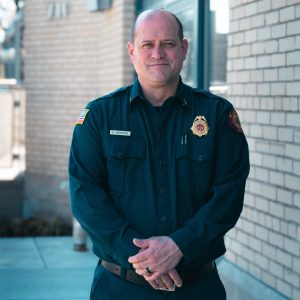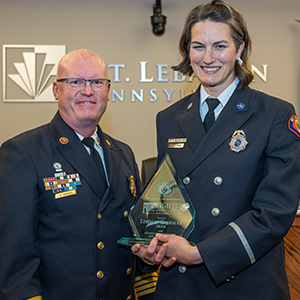Firefighter training facility approved

“I’ve been a firefighter for 38 years, and I’ve never fought a fire in a parking lot, but that’s where we train every week,” said Mt. Lebanon Fire Chief Nick Sohyda.
It’s been an ongoing struggle to provide firefighters with realistic training scenarios. The opportunities for controlled live burns, where firefighters practice their skills in a donated house, are few and far between. In the meantime, the training department has to scramble.
“We can’t practice crawling through smoke in the public safety building,” Sohyda said. “Even fake smoke sets off the alarms.”
The department can schedule time at one of the two local fire academies, in North Park and in Washington County, but it has to get in line with more than 100 other fire companies.
“We go maybe two days a year,” said Sohyda. Even then, the travel time to and from the venues, plus the time spent training, can make for a long day.
“We want to be considerate of our volunteers’ time,” said Sohyda. “If you go to North Park at 5 on a weekday, that’s an hour just to get there.”
The closest the fire department can come to realistic smoke training is to build an apparatus from plywood and pallets that resembles the layout of a house or apartment, and cover firefighters’ face masks with black cloth. In addition to the less-than-lifelike experience, firefighters have to disassemble the apparatus after they’re finished, because it takes up valuable space in the vehicle bays.
“Responding to a fire, we put a lot of different skills together,” Sohyda said.
For example, a vent-enter-search maneuver, standard practice in any structure fire, consists of throwing a ladder against a building, opening the window, checking the floor before crawling in to search the room and then closing the room door. Under the current setup, it’s next to impossible to practice all of those skills in order at the same time.
The cost of a dedicated training facility has long been a stumbling block. A purpose-built cinder block facility with special flame-resistant lining costs in the neighborhood of $2.5 million to $3 million. In the past few years, however, companies have been building training facilities from refurbished shipping containers, which cost a fraction of the price of a cinder block building.
Since the costs declined so dramatically, the fire department has wanted to build a facility.
In May, the Mt. Lebanon Commission approved plans for a fire training facility to be built on the public works campus, 1250 Lindendale Drive. As part of the same project, Mt. Lebanon will construct a storage facility that was on the original approved plans for the Public Works project—but never funded—to accommodate public works equipment that needs to be relocated to make room for the facility.
The training facility will be constructed of five 40-feet-by-10-feet-by-8-feet containers and one container that is half that size. Work on the project is expected to start next summer. Estimated cost of construction for the facility is about $620,000. State Rep. Dan Miller, a former Mt. Lebanon volunteer firefighter, secured a $200,000 state grant to help pay for the facility, and the Mt. Lebanon Volunteer Fire Company donated another $100,000.
Sohyda is quick to address any misgivings that neighbors of the facility may have concerning noise and smoke.
“We’re at public works almost three Mondays a month now,” he said. “If no one’s really complained, they must not know that we’re there. We don’t plan to make more noise with the training facility.”
The department holds drills every Monday night, and is planning to teach a firefighters’ essential course for a few Thursdays in a row. Sohyda says the plans remain to begin training after 9 a.m., and for a hard stop to all activities by 9:30 p.m. And as for smoke, the department plans to use the facility sparingly for live burns.
“Maybe two or three times a year,” Sohyda said. Allegheny County Health Department regulations strictly govern the conduct of live burns, requiring a one-week notice to be given to all residents within 400 feet of the facility; the only materials that can be burned are wood pallets, plywood and straw, and if the wind carries the smoke too far into the neighborhood, the training must be stopped and rescheduled.
“We’re not burning tires, or sofas, and we will postpone if the weather conditions are bad,” said Sohyda. “We want to be good neighbors.”





